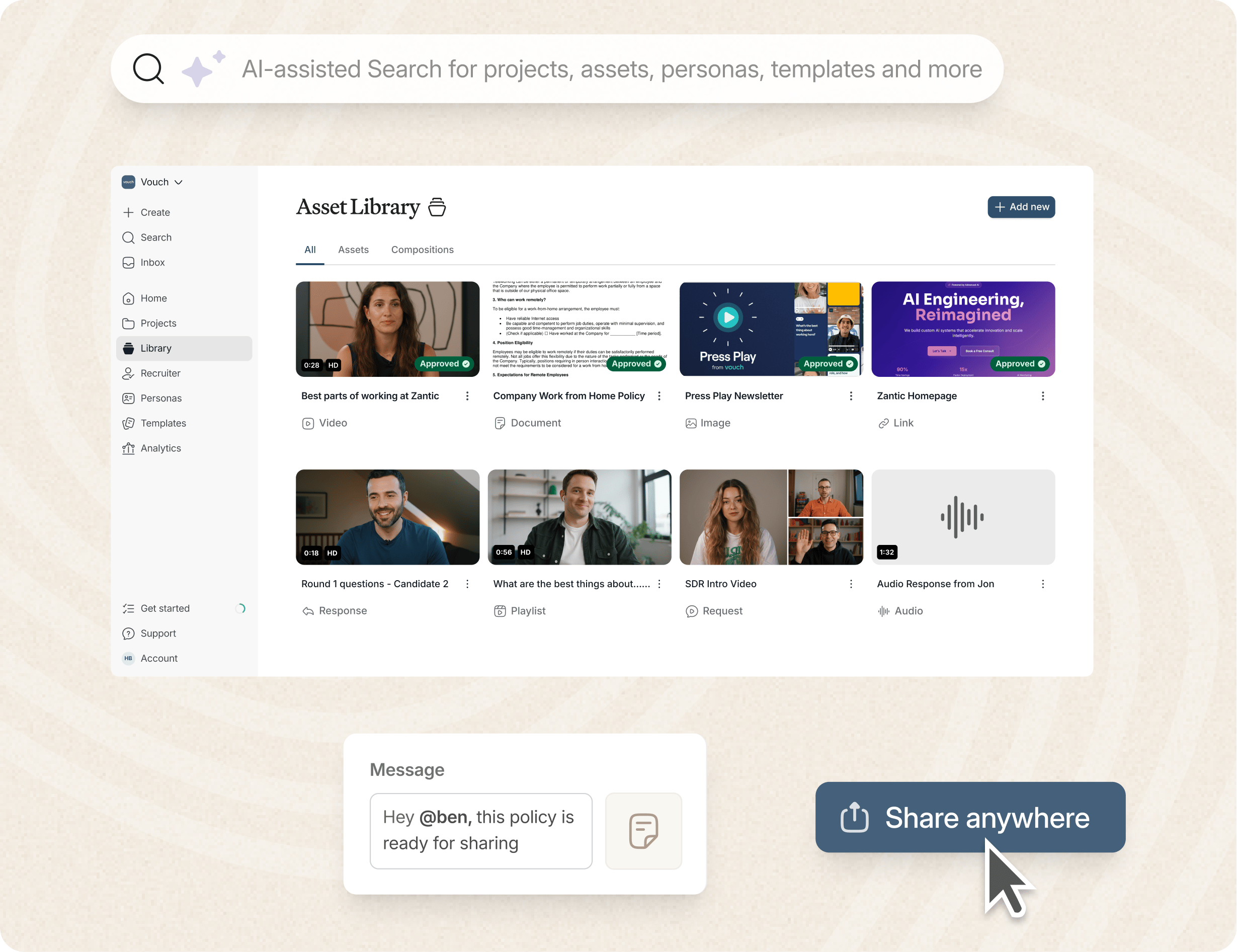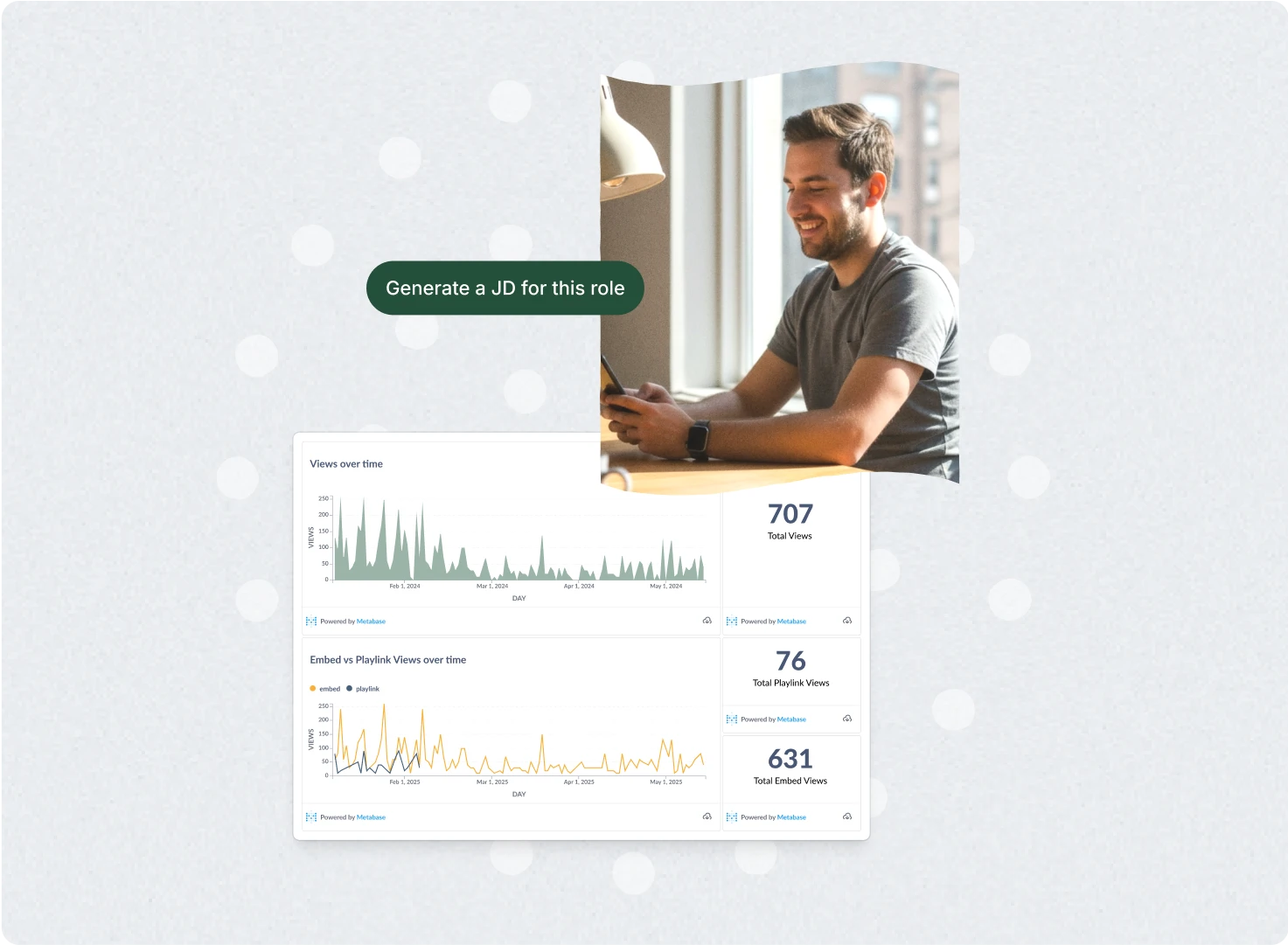Are you a recruiter looking to hire third shift workers?
According to data from the U.S. Bureau of Labor Statistics, about 9% of Americans work the third shift; other sources cite up to 15% in 2024.
The third shift was traditionally known as the overnight or graveyard shift and is the unique work period that runs from 11 p.m. to 7 a.m.
These overnight hours make things challenging for recruiters. From attracting the right candidates to performance reviews and even calling in sick, it can all be a challenge.
This is where modern video tools like Vouch can help you recruit, and stay in contact with your third-shift workers and reduce employee turnover.
So let's get started.
Key Topics Covered:
- The industries that require employees to work third shift hours
- Understanding the advantages and disadvantages of running a third shift
- Compensation and incentives you could consider for third shift workers
- How communication is vital to reducing employee turnover
What Is the Third Shift?
The third shift, also known as the overnight work period, is typically scheduled from 11 p.m. to 7 a.m. This timeframe is commonly referred to as the graveyard shift or night shift, as opposed to day shift hour.
It is one of the three common shifts through the different time of day, with the 1st shift hours being the typical 9-to-5 workday and the 2nd shift hours usually running from 3 p.m. to 11 p.m. The 3rd shift hours are therefore 11 p.m. to 7 a.m, making three shifts over 24 hours.
It's these shifts that industries such as manufacturing, retail, hospitality, healthcare, and law enforcement require to operate and serve the public.
One of the biggest challenges for H.R. with third-shift workers is maintaining employee engagement. To help, we've prepared an easy guide here: The 3 Types of Employee Engagement: For a Happier Workplace.
The AI-enabled workspace for talent teams.
- Unified workspace for talent teams
- Accelerate hiring with AI tools
- Auto-generate polished hiring and employer brand content
- Easily repurpose assets across all channel

What Are The Common Third Shift Jobs?
Many industries require third-shift employees. For many people around the world, the third shift is a desirable shift due to more pay, the ability to work part of the day, or simply a lifestyle choice to avoid the typical rush hour and busy times most of us live in.
Here are some examples of common third shift jobs:
1. Manufacturing and Print
Production lines and assembly work often continue overnight to ensure continuous production. Newspapers are also a great example where the print is done overnight for the next day.
2. Law Enforcement
Police officers and emergency responders play a vital role in maintaining safety and handling emergencies during the overnight hours. Like hospital or nursing-based healthcare workers, monitoring burnout and sleep patterns is important in higher-risk third-shift jobs.
3. Healthcare and Emergency Services
Hospitals, ambulances, fire-people, and medical facilities need healthcare personnel to provide round-the-clock care to patients. In healthcare, where burnout rates can be high, it's vital that H.R. managers keep in close contact with their third-shift workers.
4. Retail
Retail stores sometimes operate 24/7 to cater to late-night shoppers or restock inventory. Third shift or night-shift workers are also often required for restocking the stores.
5. Hospitality
Hotels staff third shift workers to manage overnight guest services and security. Unconventional times are expected in hospitality, especially around airports or bustling cities.
6. Security
Security guards are essential for overnight surveillance and safeguarding premises. For security workers, taking on a 3rd shift job can also help increase their salary.
7. Foodservice
Restaurants, diners, and fast-food chains rely on third shift employees to cater to late-night diners or perform cleaning and restocking. Fast-food restaurants alone employ hundreds of thousands of third shift workers around the world.
8. Transportation
Truck drivers and delivery personnel often work overnight and even triple shifts to transport goods and fulfill logistical needs across the country. Support teams checking in with logistics personnel might also be needed.
9. Customer Support
Call centers often require third shift employees to provide 24/7 assistance to customers, although these days, a lot of companies hire remote workers in different timezones to manage customer support needs.
These are just a few examples of industries that have employees working during the overnight hours. However, there are various other sectors that also rely on third shift workers to ensure uninterrupted operations.
How Much More Do Third Shift Employees Earn?
While the U.S.-driven Fair Labor Standards Act (FLSA) does not mandate a different hourly pay rate for third-shift workers, many employers provide a third-shift differential to attract and retain reliable people.
That is the key when it comes to third shift employees; you are paying more for people who can often work autonomously without the rest of your team being available.
The exact amount varies widely on the employer, industry, location, and other factors. In some cases, third shift employees may earn anywhere from a few cents to a few dollars more per hour compared to their daytime counterparts.
If you are hiring third shift employees, try to offer above-average rates and various incentives to make the third shift more attractive, with perks such as free meals, increased availability of coffee, or longer breaks.
By providing these additional benefits, you can create a positive work environment and reward employees for their dedication to the third shift.
What Are The 5 Advantages of Running a Third Shift?
Running a third shift is mandatory for many industries, such as healthcare, law enforcement, and emergency services. But what if you run a manufacturing plant?
It can often be a difficult decision to start a third shift with more OH&S considerations, especially when heavy machinery is involved.
Here are five reasons why implementing a third shift can benefit your company.
1. Increased Output
By far, the biggest benefit is that by extending your operational hours, you provide more time for tasks to be completed and potentially deliver products in less time. This could be a big differentiator for many manufacturing companies and even software companies, where many employees are night owls.
2. Potentially Reduced Burnout
If your workload is immense, you can run the risk of employee burnout. Distributing the workload across different shifts, including the third shift, can help alleviate burnout among first and second shift employees.
3. Improved Customer Service
Offering 24/7 service through a third shift enables you to provide round-the-clock customer support. This availability enhances customer satisfaction, loyalty, and retention, leading to potential growth and increased revenue. The challenge is finding the suitable customer support agents, as they will likely need to be more adept than their daytime counterparts.
4. Attraction of Different Talent
Implementing a third shift allows you to tap into a pool of talent that prefers working non-traditional hours. Some individuals thrive during nighttime hours and often like to lead more private lives instead of working in larger teams. By offering this option, you can attract talented individuals who may prefer these work hours.
5. Crime Deterrence
Having employees work overnight can act as a deterrent to potential crimes, ensuring the safety of your business premises and assets.
By carefully considering your business's specific needs, you can optimize your operations and drive success over competitors who don't operate during the third shift.
What Are The 5 Disadvantages of Running a Third Shift?
While running a third shift can have its benefits, it's important to acknowledge the disadvantages that come with it. One of the primary considerations is employee work-life balance.
Naturally, we are not discussing essential services here. We are talking about private companies in areas such as manufacturing, software development, food services, logistics, etc.
Here are five challenges many companies encounter:
1. Increased Costs
Adding a third shift, of course, means additional workers and overhead expenses, with increased wages and penalty rates depending on your country, which can lead to increased operational costs.
2. Potential Accidents
Fatigue and a drop in energy levels and focus can be a significant concern for employees working overnight, potentially increasing the risk of accidents and, in turn, higher workers' compensation costs.
There are of course also potential sleep disruptions and circadian rhythm issues as third shift workers need to sleep during the day, when the world is a lot busier and noisier. It's this disrupted sleep schedule that you need to stay aware of at all times.
3. Employee Turnover
The non-traditional hours of a third shift can make it difficult for employees to maintain a healthy work-life balance and can even create social isolation, leading to higher turnover rates. This is where video tools like Vouch can help, as you can keep a personal connection with your teams.
4. Difficulty Filling Positions
Finding qualified candidates for third shift positions can be challenging, as there may be a limited pool of applicants available during those hours. You also need highly reliable people who can operate without the rest of your business, who are only available in regular business hours.
5. Communication Issues
When employees work at different hours, communication can become a challenge, resulting in potential errors and miscommunications. Ensuring crystal-clear communication across shifts is vital at all times. Tools like Vouch can help as little gets lost in video.
While these disadvantages should be taken into consideration, implementing strategies and proper communication tools to mitigate these challenges can help ensure the success of your business when running a third shift.
What Questions Do You Need To Ask Before Adding Overnight Employees?
It is crucial to ask the right questions before deciding to add a third shift to your business. So, let's examine some considerations.
Evaluate Customer Expectations
Do your customers expect 24/7 support or extended service hours to deliver products on time? Understanding customer needs is essential in determining whether a third shift is necessary.
Assess The Costs VS Rewards
Third-shift workers are essential for essential services like law enforcement and healthcare. For private companies, additional expenses such as increased labor costs and overhead expenses need to be carefully calculated, along with the costs of safety risks and insurance.
Consider Employee Availability
Are your current employees willing to work overnight, or do you need to hire? Assess the level of interest and willingness among your current workforce to determine if they are willing to work overnight shifts. If not, you may need to consider recruitment strategies like these.
Assess Safety Risks
Adding another shift may introduce additional safety risks, especially if you are looking at some current employees moving across, as this can completely change their sleep routine. This may include implementing security protocols, looking at lighting compliance, or offering third shift training programs to mitigate any potential risks.
Determine Shift Schedules
Decide whether you will rotate employees between different shifts or hire workers specifically for the third shift to meet your business demands. Consider the impact on employee morale, work-life balance, and overall scheduling requirements and management tools.
What's The Best Way To Hire Shift Workers?
One of the most challenging parts of hiring third shift workers, is communications with candidates and employees as they live in a completely different time zone. Third shift workers are often going to bed when you wake up.
That's why when it comes to hiring new third shift workers, tools like Vouch can help tremendously across any industry - from essential services to private companies.
FAQs
What is the third shift?
The third shift, also known as the overnight or graveyard shift, is the work period that typically runs from 11 p.m. to 7 a.m.
What are some typical third-shift jobs?
Common third-shift jobs include those in manufacturing, retail, hospitality, security, food service, healthcare, transportation, law enforcement, and customer support.
How much should I pay a third-shift employee?
While the Fair Labor Standards Act (FLSA) in the USA does not mandate a different hourly pay rate for third shift workers, many employers choose to provide a night shift differential, and employers may also offer incentives such as free meals, increased coffee availability, or longer breaks.
What are some advantages of running a third shift?
Running a third shift can increase productivity by providing more time to complete tasks, reduce burnout among first and second shift employees, enhance customer support and satisfaction, attract different talent, and deter crime to ensure the safety of the business.
What are some disadvantages of running a third shift?
Running a third shift can increase business costs, pose a higher risk of accidents due to tired employees, make it challenging for employees to maintain work-life balance, create difficulty in finding qualified candidates, and present communication challenges between shifts.
How can I make the third shift work for my business?
Communication is everything, along with setting clear expectations and implementing efficient scheduling systems. Support and feedback to third shift employees is also vital for your team and business.
Conclusion
Adding a third shift to your business can be a strategic move, but it's important to carefully consider your company's unique circumstances. If you manage an essential service like emergency services or police teams, for example, you already know the ins and outs of third-shift work hours.
Private or public, effective communication is critical, which includes during the recruitment process where tools like Vouch video can help.
Finally, consider proper compensation to attract, and retain the very best third shift workers.
Like to try Vouch?
Loved by companies like Canva, Nike, Cisco, HubSpot, Amazon, and more, tools like Vouch make leveraging video in your business communication and recruitment remarkably easy.
Be sure to book a Vouch demo today and chat with a video content expert.
You might also like

Elevate Your Brand Today With Vouch
Discover how Vouch can accelerate talent acquisition while helping you stay on-brand.






